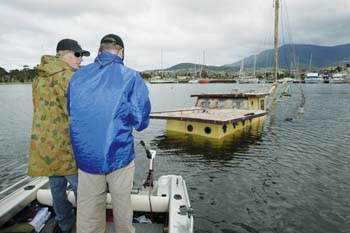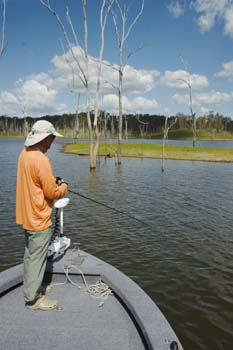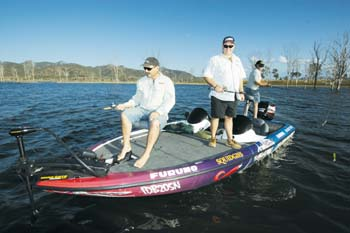Electric Motor Selection
- NAFA
- Feb 1, 2008
- 6 min read
Updated: Apr 2, 2020
By Warren Steptoe
HOW BIG? 12 or 24V?
Warren Steptoe provides practical answers to all your electric questions.
It’s almost reached a point for lake, estuary, and river fishers where an outboard motor is used to travel from place to place, and an electric motor to fish. You could easily say that fishing with an electric motor is pivotal to success with many techniques popular these days.What barra, bass, or bream fisher doesn’t shut down the outboard and lower the electric when they start fishing? Out on open water, in a radical departure from traditional drifting approaches, tuna spin and fly fishers are using electric motors to silently stalk cautious surface feeders. Our burgeoning flats scene is another where the stealthy approach of an electric motor is particularly beneficial. Credible pundits opine that electrics are a better way to go on Antipodean skinny water (where we apparently tend to fish slightly deeper water) than the push poles so popular Stateside. When it comes to slow, slow trolling, widely considered the most productive way to extract those mega barra taking the impoundment fishing scene by storm … doing it silently under electric power is generally considered the best way. Certainly it is in my opinion, whenever wind conditions allow. Fishing soft plastics over shallow reefy country for snapper is yet another situation where gun anglers universally rely on electric motors to control their drift. Yes indeed, fishing with electric propulsion has expanded a long way past the lure casting snags scene, where electrics initially came into common useage. It’s fair to say that many contemporary techniques actually evolved around electric motors. Yet despite all of the above, it’s still surprisingly difficult to get straight answers to fundamental questions about electric motors. Like how big an electric motor any given hull needs, whether it’s better to mount one on the bow or stern, and whether or not your boat needs a 24 volt system? So let’s see if we can provide some of those answers … How Big? Size is a very important thing, an ageless home truth no less applicable here. To begin with, and unfortunately, while boat builders must rate outboard power requirements, none even suggest how much thrust their boats need to perform adequately with an electric motor. (Why not is a good question now we come to mention it!) All that’s available to help the inexperienced are charts provided by motor suppliers, such as the Select-A-Motor feature available on the Minn Kota website (www.minnkotamotors.com). These often give an approximate maximum hull size for their range of motors — and from there you’re on your own. If you know a few people who have been there and done that with electrics you’re lucky. They’re probably the best source of information regarding what size motor you might need. For what it’s worth, having been around electrics awhile and having owned a couple myself, I’d suggest the max lengths from most manufacturers refer to low sided boats such as American bass boats; the sleek lines of which offer far less windage than higher sided hulls so popular here — which need more grunt to maneuver. My own experience suggests it’s worth chopping a metre and a half or more off Minn Kota’s max hull lengths for their larger motors and half that for their smaller. With pro-rata thinking in between, you’ll get somewhere near the money for the kind of boats Aussies use. For example, my 4.5 metre Haines Traveler (with medium height sides) is nicely powered by a bow mounted Minn Kota Riptide 55 (rated up to 6.4 metres) in any conditions it’s practical to fish on the electric. Therefore it seems to me that windy weather would be a big ask for the same motor on a proportionate 6 metre boat… My previous 3.8 metre Savage Jabiru pointy punt was just OK with a 28 pound thrust motor (rated to up to a 4.3 metre hull.) That was until I mounted it on the bow, where it worked very well… thus Steptoe’s rule of thumb. We’ll come back to the bow/stern mount business shortly, because it’s also very important! It’s certainly possible to overpower with an electric, and there is a point where a more powerful motor offers little extra benefit. Below that point, electrics are very like outboards, in that more powerful motors running at less “throttle” tend to be more economical (in terms of battery drain obviously) than a less powerful model which has to work harder. The last aspect of size is shaft length. You see a lot of boats fitted with too-short electrics which causes problems when the propeller isn’t deep enough in the water, causing it to “grab” air from the surface and ventilate, compromising the propeller’s “grip” and thereby the motor’s effective thrust. And the situation progressively worsens the rougher conditions get. Especially with direct (tiller) steer electrics, short motors don’t reach upwards towards the person using them far enough, and they literally become a pain as you constantly bend down to steer. This can be simply avoided by choosing a long enough shaft to begin with. Bow or Stern Mount? This common question is easily answered — mount it on the BOW! Any boat steers remarkably better at electric speeds when drawn from the bow rather than pushed from the stern. Also, stern-mounted electrics drain dramatic amounts more power, and are less effective. People on restricted budgets should take heart that so called “transom mount” electrics, (the lower cost models) can usually be bow mounted, albeit with some ingenuity, and usually a bit of bush engineering to fabricate an appropriate bracket. Then the top of most ostensibly transom mount motors may be rotated 180 degrees, allowing them to be bow mounted quite successfully. But while dreaming up your low cost bow mount, to avoid the literal pain mentioned before, pay attention to the ergonomics of using it. There’s much to be said in favour of direct-steer bow-mount electrics, which some say provide the best control of all — but not when they’re uncomfortable to use! In my experience, tiller extensions are very rarely NOT necessary for comfortable fishing with a direct steer electric motor. Direct or Remote Steering? If operating a well set-up, direct-steer, bow-mount electric motor is a real pleasure, newcomers to electric power can expect a period of orientation (and a few good laughs) before becoming au fait with remote control models. Remote foot and hand controls are well and good, but just the same as tiller steering an outboard provides simpler, more accurate and immediate steering, so too do direct steer electrics. If a direct steer electric fits your budget better, go for it, because they provide all the benefits of fishing under electric power. Having said that though, with cable and electronic foot controls, and the recent arrival of wireless remote hand controls, the choices in remote steering have never been better. I’ve been using a wireless remote hand control for over a year now and there’s no way you’d get me back to a foot control. Doing away with that bloody cable draped across the deck to the remote is simply wonderful! Minn Kota’s “Auto Pilot” function combined with their wireless remote “Co Pilot” system actually added a new dimension to my electric motor fishing. In a variety of situations, particularly slow trolling and anywhere I can let the boat move itself along while everybody casts, these features allow me to let the boat run itself while I concentrate on fishing. Battery Saving Circuitry By whatever fancy name it’s called, battery saving electronic wizardry is worth having. It extends battery life substantially, and is well worth a few extra bucks. Fresh or Salt Water Motors If there’s a bottom line here, it’s that saltwater electric motors are built with saltwater-resistant engineering, while freshwater ones aren’t, and will eventually suffer problems from constant saltwater useage. While an odd venture into the salt followed by a thorough wash down and spray with corrosion inhibitor won’t hurt a freshwater motor, everyone I’ve ever seen use freshwater electrics in the salt ended up facing saltwater-related issues such as corrosion and electrical dramas. It’s why motors are rated for saltwater — and why there’s no problem operating saltwater motors in the sweetwater! 12 Volts or 24? Basically, 24 volt electric motors provide more grunt in terms of both motive power and battery life. However, whether some of the sub 5 metre boats running 24 volt systems really gain much from the considerable extra expense, substantial extra weight, extra battery bulk and the more expensive and complicated set up of 24V systems is a very good question. For what it’s worth, having worked through the considerations, I’m happy with the 12V system in my boat. It’s proven more than adequate for both trolling and casting under electric power, despite a fairly heavy and reasonably wind-prone hull. Perhaps some people get a bit carried away (as us fishos tend to do with gear-associated matters) with the need for 24V systems. Some of the stuff you see on various website chat rooms is out there, that’s for sure. Obviously larger and more wind-prone hulls have little choice, while ones with less windage can be well enough served by a 12V setup. Probably, the typical 4.3 to 5 metre boats many of us use sits in a grey area somewhere between — this is why opinions differ so widely. In the end, before choosing and then setting up an electric motor, it’s always good to talk to as many people as you can find with similar rigs to yours and make your final decision from there. They don’t have to be the same brand, but similar dimensioned hulls with similar windage and similar weights. We hope we’ve answered a few questions to get you started.










